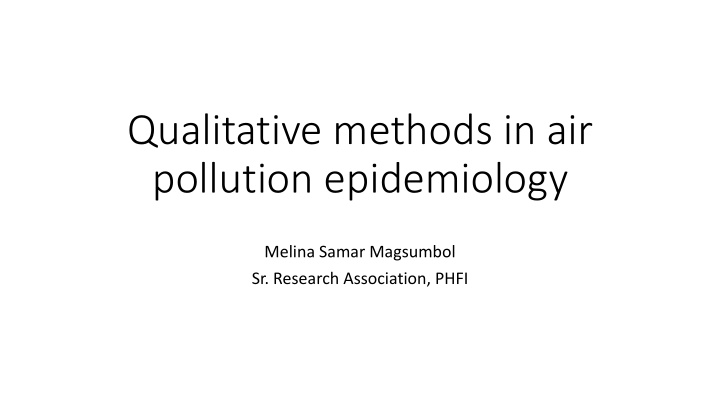



Qualitative methods in air pollution epidemiology Melina Samar Magsumbol Sr. Research Association, PHFI
Qualitative approach • Operationalizing certain constructs (poverty – income?; gendered interactions – empowerment?) • Design (rapid appraisal) • Mixed methods
Research issues • Understanding/awareness of the relationship between air pollution and cardiopulmonary problems • Risk perception and behavioural modifications among those suffering from cardiopulmonary problems • Harm reduction strategies (protective behaviors) to reduce exposures, if any • Knowledge, perception and attitudes towards air pollution of various stakeholders
Advantages (Scammell 2010, Env Health Persp) • Qualitative data will add to understanding of specific exposure pathways • Provide information on perceptions of risk/susceptibility, harm reduction strategies • Socio-economic/gender/cultural gradients modify exposures and health outcomes • Intervention planning
Methods • Participant observation (PO) for specific behaviors that predispose participants to exposure to air pollution (ex. commuting, occupation) • Validate time/activity questionnaires • Contextualize data captured by personal air monitors • Effective messaging / risk communication • FGDs to identify harm reduction practices • Hazards identified by community (local sources – ex. factories)
Examples
Straw burning in Punjab • Villages in Fazilka district – 2 years no straw burning • Biomass powerplant • Service and machinery provider • Value Chain Approach Technology adoption/constraints • Benefits derived; economic vs health • Organization of farmers’ groups • Innovations – service delivery
Infrastructure Entrepreneurs Agriculture Farmers Groups department Innovative scheme – harvester Research Payment scheme institutions Farmers as drivers- Logistics of straw owners- service Availability of loans collection providers Business opportunities
Physicians and air pollution • Understand the knowledge, attitude and behaviour of physicians towards health effects of air pollution • Understand the role of the physician as a practitioner and as a policy actor • Role as advocate, policymaking (individual and as a collectivity) • Upstream thinking • Key informant interviews and semi-quantitative survey
Pesticide use and cultural constructs • Symptoms of pesticide poisoning among male farmers – normalized • Home remedies, or went to indigenous healers • Serious cases of poisoning (seizures, vomiting, loss of consciousness) reach hospital and get recorded • Harm reduction practices countered medical advice • Women used pesticides for household/gardening, dengue control • Conflict between those who practice integrated pest management and heavy pesticide users • Participant observation, KI, economic and health survey, agricultural inputs
Qualitative approach • Operationalizing certain constructs (poverty – income?; gendered interactions – empowerment?) • Design (rapid appraisal) • Mixed methods
Recommend
More recommend